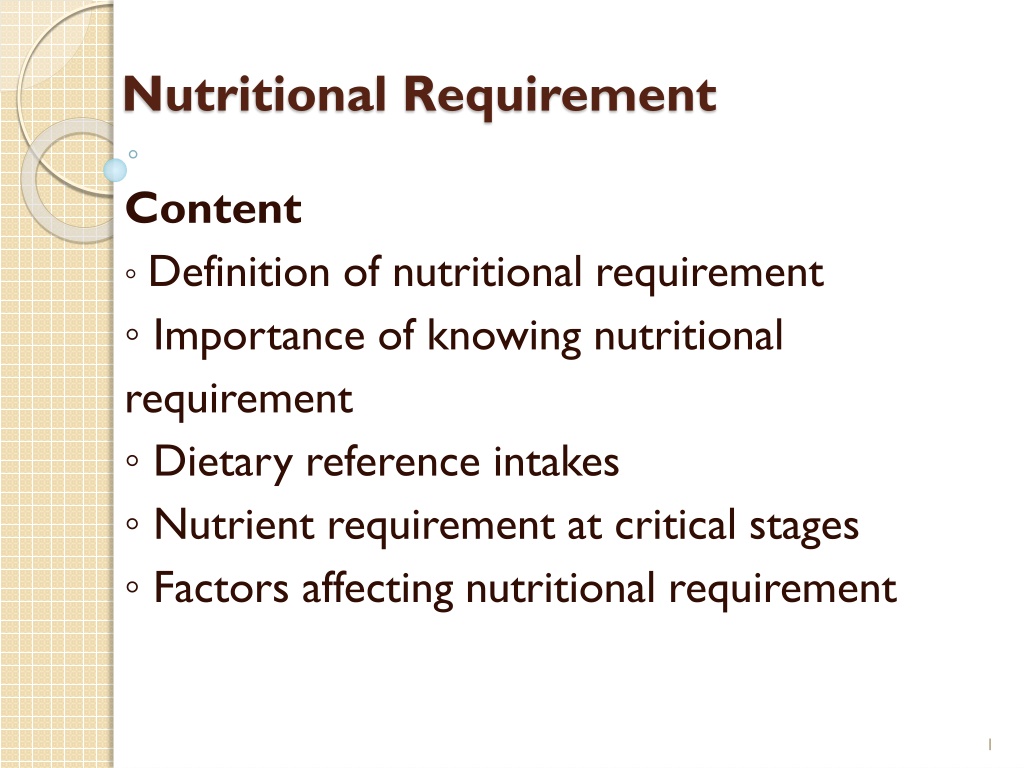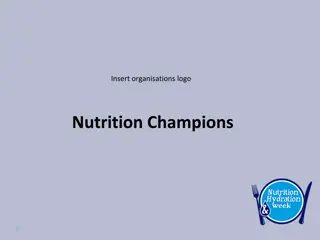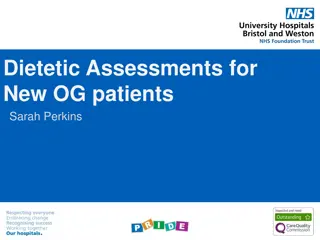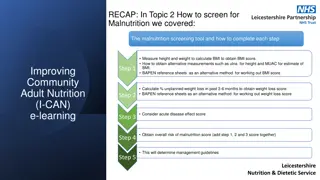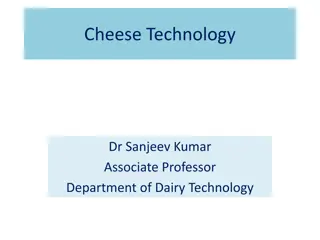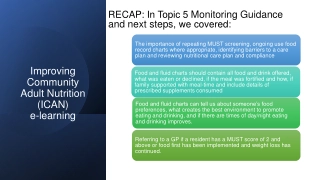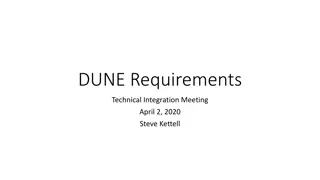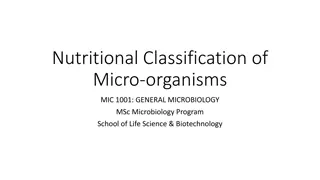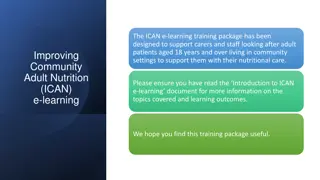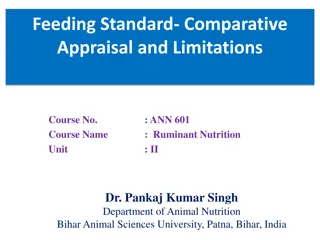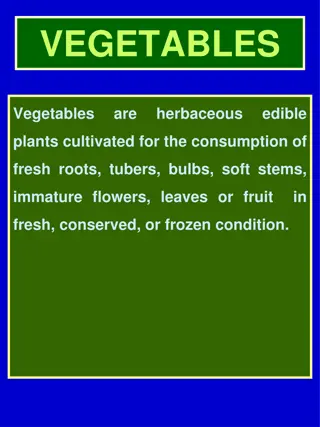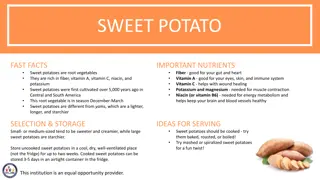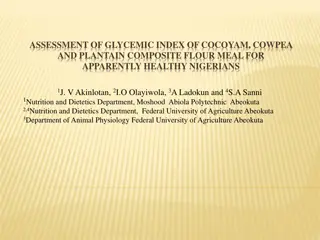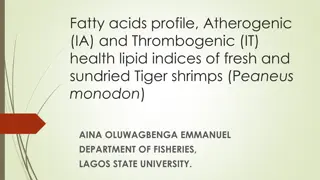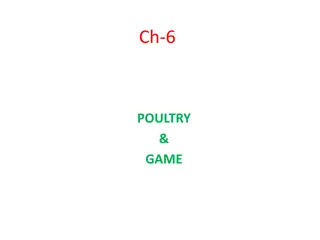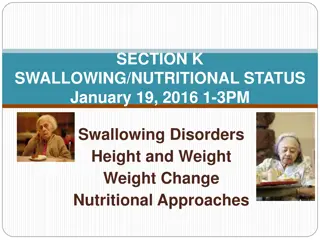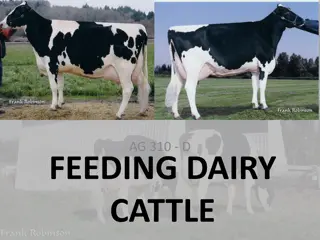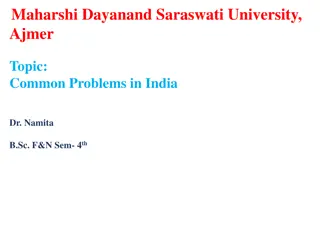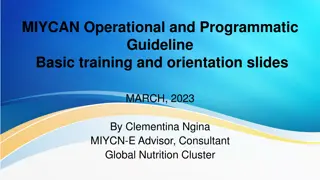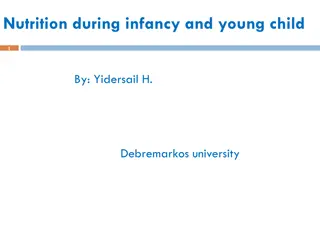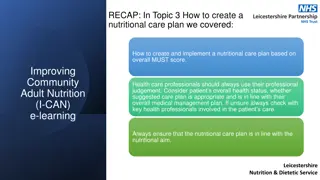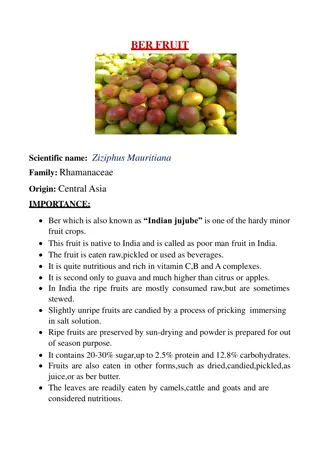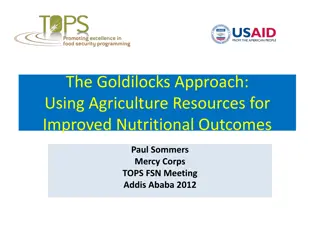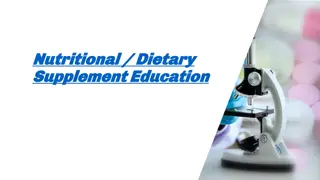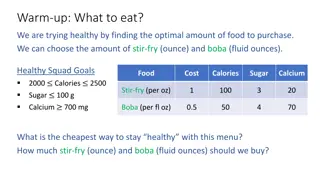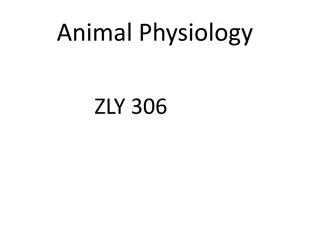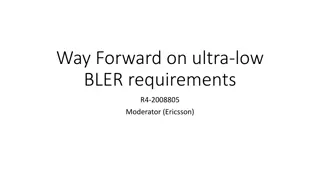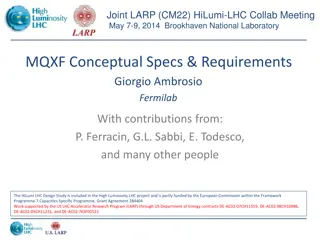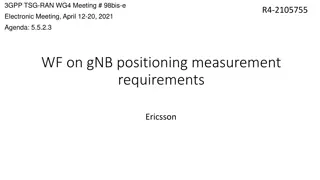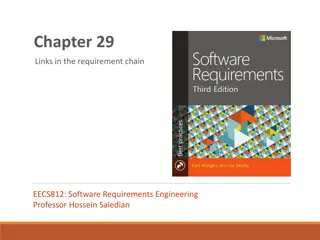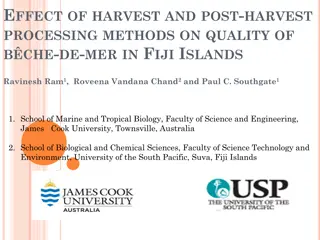Understanding Nutritional Requirements and Their Impact
Exploring the definition and importance of nutritional requirements, as well as the Dietary Reference Intakes, critical stages for nutrient needs, and factors influencing nutritional requirements.
Download Presentation

Please find below an Image/Link to download the presentation.
The content on the website is provided AS IS for your information and personal use only. It may not be sold, licensed, or shared on other websites without obtaining consent from the author. Download presentation by click this link. If you encounter any issues during the download, it is possible that the publisher has removed the file from their server.
E N D
Presentation Transcript
Nutritional Requirement Content Definition of nutritional requirement Importance of knowing nutritional requirement Dietary reference intakes Nutrient requirement at critical stages Factors affecting nutritional requirement 1
Learning objectives: At the end of the session students are expected to: - Rationale of knowing nutritional requirements - Describe the principle behind estimation of nutritional requirement - Know the different factors that affect nutritional requirement 2
Introduction What is nutritional requirement? A nutritional requirement is defined as the lowest continuing intake level of a nutrient that, for a specified indicator of adequacy, will maintain a defined level of nutriture in an individual. Nutriture- bodily condition with respect to nutrition and especially with respect to a given nutrient. 3
Why do we know nutritional requirements? Determining food and nutrition adequacy of population food intakes Determining nutrient needs, and evaluating and ensuring the adequacy of ration quality and quantity for vulnerable groups (refugees, in times of conflict or famine ). Providing information to manufacturers of infant formula and processed complementary foods 4
Dietary reference intakes (values) A set of standards that define the amount of energy, nutrients and other dietary components that best support health. Include: Estimated Average Requirement (EAR) Recommended Dietary Allowance (RDA) Lower reference nutrient intake (LRNI) Adequate Intake (AI) Tolerable Upper Intake Level (TUL) 5
Estimated average requirement (EAR) It is the average daily nutrient intake level that meets the needs of 50% of the healthy individuals in a particular age and gender group. 50% of subjects would not have their needs met. 6
Reference Nutrient intake ( RNI) or Recommended Dietary Allowance (RDA) The daily amount of a nutrient considered adequate to meet the known nutrient needs almost all (97.5 percent) apparently healthy individuals in an age and sex-specific population group. Note: Recommendations are set high enough above the estimated average requirement to meet the needs of most healthy people 7
Lower Reference Nutrient Intake (LRNI) The minimum amount of a nutrient that is enough for only the small number of people who have low requirements (2.5%) The majority of the population need more 8
Adequate intake ( Safe intake) The average daily amount of a nutrient that appears sufficient to maintain a specified criterion. . These values are based on observed or experimentally determined estimates of nutrient intake by a group (s) of healthy individuals. At this level there is no risk of deficiency and is below the level where there is a risk of undesirable effects. 9
Upper tolerable nutrient intake level The maximum daily amount of a nutrient that appears safe for most healthy people and beyond which there is an increased risk of adverse health effects. Note: UTNI serves as a reminder to keep nutrient intakes below amounts that increase the risk of toxicity 10
What is energy requirement? is the amount of food energy needed to balance energy expenditure in order to maintain body size, body composition and a level of necessary and desirable physical activity consistent with long-term good health. This includes the energy needed for the optimal growth and development of children, for the deposition of tissues during pregnancy, and for the secretion of milk during lactation consistent with the good health of mother and child. WHO, FAO, UNU 11
Energy requirement... Energy requirements are also based on the following factors: 1. Basal metabolism - Need to maintain vital functions - Depends on age, sex, body composition ,etc 2. Metabolic response to food - Needed for digestion , transport and metabolism of nutrients 3. Physical activity - all daily activities ranging from work to play to rest. These activities may be occupational, associated with work, or discretionary, associated with household and social tasks. 12
Energy requirement... 4. Growth - For forming new tissues ,and energy deposited in those tissues. 5. Pregnancy - Production of fetal and maternal tissues 6. Lactation - For milk production( secretion) and energy stored in the milk 13
Nutritional Requirement during critical periods Contents Nutrient requirement during: Pregnancy Lactation Infancy Old age 14
Nutrient requirement during pregnancy Women s increase during pregnancy. When energy and other nutrient intake do not increase, the body s own reserves are used, leaving a pregnant women weakened. Pregnant women also require more protein, iron, iodine, vitamin A, folate and other nutrients. Deficiencies of certain nutrients are associated with maternal complication and death, fetal and newborn death, birth defect, decrease physical and mental potential of the child. nutrient requirement substantially 15
Energy requirement during pregnancy 300 kcal/day extra amount of energy is required (14% more than non pregnant non lactating). Protein Needed for the development of new material tissue as the placenta and the expansion of the uterus, breasts, and blood volume as well as the development of fetal tissue. 10 g/day more than RDA is need 16
Energy requirement during pregnancy 300 kcal/day extra amount of energy is required (14% more than non pregnant non lactating). Protein Needed for the development of new material tissue as the placenta and the expansion of the uterus, breasts, and blood volume as well as the development of fetal tissue. 10 g/day more than RDA is need 17
Energy demands of Lactation Much greater than that of pregnancy. Attributable to rapid growth of infants. Some of the energy is derived from maternal stores during pregnancy. 23% increase in energy demand over a non-pregnant , non lactating woman. 20
Macro-nutrient need during lactation Carbohydrate-RDA - 210g/day ( Extra 550- 840 kcal. Protein RDA- 71g/day (extra 284Kcal) Lipid-RDA- 30g/day 21
Infancy Is a period from birth to the completion of first year. Characterized by the most rapid growth in human life. Length increases by about 40% and weight is tripled. Head circumference is also increased by about 30%. 23
Energy foods and energy nutrients A new born requires about 90-120 kcal/kg BW versus an adult requirement of 30-40kcal/kg BW for maintenance. Most of the energy is required for BMR followed by for growth. 24
Protein Still the highest period in human life in terms of protein requirement. 1.98g/kg of BW is required for proper growth to occur. RDA for infants is 2.2g/kg for the first 6 months and then reduced to 2g/kg in the second 6 months. 25
Fat and fatty acids - More than half of the energy in BM is derived from fat. - Essential fatty acids are required in larger amount during infancy (>30% of the total energy). Mainly for neurological development. Milk is a better source of both omega-3 and 6 PUFAs. 26
Vitamins and Minerals Consumption of 700-800 ml of BM provides twice RDA of Vitamin A but same intake will not allow the acquisition of RDA of Vitamin D. BM is not also a good source of Vitamin K , it is recommended to be given routinely at birth. If the mother was taking enough Fe during pregnancy , the iron store in the infant is enough for the first 6 months of life. Fe supplementation is needed after 6 months of life. 27
Old age An elderly person requires less energy than a younger individual due to reductions in muscle mass and physical activity. Some daily nutrients requirements for elderly people differ from those of younger adults. For example, in order to reduce the risk for age related bone loss and fracture, the requirement for vitamin D is increased from 200 IU/day to 400 IU/day in individuals of 51-70 years of age and to 600 IU/day for those over 70 years of age. 28
Cont. However, iron requirement reduced from 18mg/day to 8 mg in elderly women due to better iron conservation and postmenopausal women compared with younger women. Some elderly people have difficulty in achieving adequate nutrition because of age or disease related impairments in chewing, swallowing, digesting and absorbing nutrients. decreased losses in 29
cont.. Therefore, for older people, as with younger adults,, the diet should follow the principles of a healthy balanced diet ( food guide). Bread and other cereals and potatoes Fruit and vegetables Milk and dairy products Meat, fish, and alternatives Foods containing fat and sugar 30
Nutritional Assessment Learning Objectives At the end of this session you should be able to: o Define nutritional assessment. o Identify methods of nutritional assessment. o Describe the advantages and disadvantages of each nutritional assessment method. 31
Introduction What is nutritional assessment? Nutritional assessment is an interpretation of anthropometric, biochemical (laboratory), clinical and dietary survey data to tell whether a person/ group of people is well nourished or malnourished (Over nourished or under nourished). There are two methods of assessing Nutritional status: 1. Direct method 2. Indirect method 32
Indirect methods - include assessment of indicators of the food and nutrition situations in the area/ region of interest by looking at certain data that are closely related to malnutrition or which are aggravated by malnutrition. - These include: - Cause specific mortality rates - Age specific mortality rates - Meteorological data (rainfall data ) - Production pattern and distribution pattern - Market price of foods 33
Direct methods Involve the direct measurement of body dimensions and proportions, determination of tissue or body fluid concentrations of nutrients, dietary intake, appearance of the clinical symptoms and signs. They abbreviated as the ABCDs A=Anthropometry B= Biochemical/Biophysical, C= Clinical, D= Dietary 34
A. Anthropometric assessments Anthropometry comes from two words: - Anthropo = Human, and - Metry = measurement. Definition: - Anthropometry refers to measurement of variations of physical dimension and gross composition of human body at different levels and degrees of nutrition (Jelliff, 1966). 35
Cont Anthropometric measurements could be used both in the clinical and field set-ups. In the clinical set-ups they are used to assess the nutritional status of: severely malnourished patient to assess the impact of nutritional intervention. 36
Purposes of Anthropometric measurements Anthropometric measurements are performed with two major purposes in mind: IN CHILDREN: to assess physical growth IN ADULTS: to assess changes in body composition or weight. The following body measurements are good indicators of growth performance of children at different ages when combined with the cut-off points. 37
Anthropometric measurements of growth 1. Head circumference (HC) Measured using flexible measuring tape around 0.6cm wide to the nearest 1mm. It is the circumference of the head along the supra orbital ridge anteriorly and occipital prominence posteriorly. HC is useful in assessing chronic nutritional problems in under two children. But after 2 years as the growth of the brain is sluggish it is not useful. 38
2. Length o A wooden measuring board (also called sliding board) is used for measuring length. o It is measured in recumbent position in children <2 yrs old to the nearest 1mm. o It is always > height by 1-2cm. o An assistance of two people is needed in taking the measurement. 39
3. Height Is measured in children > 2 yrs and adults in standing position to the nearest 0.1 cm. The head should be in the Frankfurt plane during measurement, knees should be straight and the heels, buttocks and the shoulders blades, should touch the vertical surface of the stadiometer (anthropometer) or wall. Stadiometer or portable anthropometer can be used for measuring. There is also a plastic instrument called acustat Stadiometer that is cheaper than the conventional Stadiometer. 41
4. Weight Most accurate and sensitive method of measuring growth is weight gain. Suspended scale & weighing sling is used for measurement of weight in children < 2 years. In adults and children >2 years, beam balance is used. 43
Indices derived from these measurements What is an index? It is a combination of two measurements or a measurement plus age. The following are few of them: - - Head circumference-for age - Weight -for-age - Height-for age - Weight for height 45
Meanings of the indices derived from growth measurements 46
Both weight for age and weight for height are indices sensitive to acute changes to nutritional status. Height for age of children in a given population indicates their nutritional status in the long run. 47
Indicator An indicator is an index + a cut-off point. E.g. - W F A < 60% = is indicator of severe malnutrition - BMI < 16 kg/m2 = indicator of severe chronic energy deficiency - W F H < 7o% = is indicator of severe wasting 48
Assessment of body composition Linear growth ceases at around the age of 25-30 years. Therefore, the main purpose of nutritional assessment of adults using anthropometry is determination of the changes of body weight and body composition. 49
Assessment of body composition using anthropometry In assessing body composition we consider the body to made up of two compartments: The fat mass and the fat free mass. Total body mass= Fat mass + fat free Mass. Therefore different measurements are used to assess these two compartments: 50
